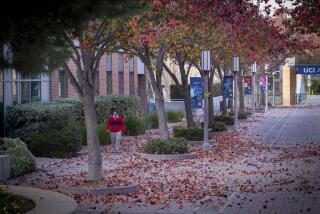Cal Poly President Was Overpaid $10,000 in Housing Allowance : College: Bob Suzuki accepted the money despite an agreement halting payments once his on-campus residence was renovated. He says the money was used for proper expenses.
POMONA — The president of Cal Poly Pomona collected $10,000 in off-campus housing allowance for almost a year after repairs to his on-campus house were finished--despite an agreement with the state that said the payments were to stop once the repairs were done.
In fact, even after President Bob Suzuki had fully moved into the university’s Manor House in early spring of this year, he continued to collect the $1,000-a-month allowance through July.
It is not unusual for Cal State presidents to receive a housing allowance if they live off campus. In Suzuki’s case, the Chancellor’s office drew up an agreement to pay Suzuki $1,000 per month in state funds until the university finished renovating the house.
The agreement, dated Sept. 10, 1991, said the housing allowance was intended to last only “until the house is ready for occupancy, at which time President (Bob) Suzuki is required to occupy the president’s house.”
The document stated that “It is anticipated that the house will be available prior to the conclusion of the (1991-92) academic year.”
Suzuki defended his actions, saying the money was placed into a separate account each month and was used for operating expenses and buying items such as toilet paper and furniture for the master bedroom.
“The expectation at the time (of the agreement with CSU) was that it would take two to three years to raise sufficient funds from private sources to undertake at least a basic refurbishment of the Manor House,” Suzuki said last week in a prepared statement.
“Although funds for even this basic refurbishment (which still has not been done) were not raised, I agreed at the outset to accept the allowance for no more than two years with the understanding that we would be living sporadically in and out of the house during this period and that the allowance would be used entirely to help cover the cost of refurbishment.”
But the written agreement provided by the Chancellor’s office says nothing about two years; it estimates that the repairs will take less than a year and says that the allowance will last only until the house is ready.
Repairs to the president’s university house--known as the Manor House--cost more than $60,000 and took longer than anticipated, finishing in September, 1992. But Suzuki did not move in full-time at that point, saying that he hoped to raise more money for further refurbishment, and continued to take the housing allowance. Even after Suzuki gave up the quest for more money and moved in in March or April, he continued to receive the payments. His last one was in July.
An official from the Cal State Chancellor’s office said she did not yet have a full picture of what had transpired with Suzuki’s housing allowance but would make inquiries.
“It’s not unusual that the allowance continue until the president does in fact move into the residence,” said June Cooper, vice chancellor for human resources and operations. However, once that occurred, “I would normally expect that the allowance would then cease.”
Current and former Cal Poly administrators say the Manor House had been unoccupied for at least 14 years and needed numerous renovations and repairs when Suzuki first saw it in 1991, including painting walls, making some plumbing repairs and pulling up old carpeting.
Cal Poly spent almost $30,000 in state funds making those repairs in fall and summer of 1992. In addition, Suzuki said he used $32,000 that the previous president, Hugh O. LaBounty, had set aside in the Cal Poly Foundation to renovate the house. The foundation is a private, nonprofit auxiliary that raises money and provides services for the university.
Suzuki said he used the Foundation money to refinish the hardwood floors and buy appointments for the house, including four Oriental carpets that cost $20,000.
The plumbing still doesn’t work properly and the house still lacks items such as some window coverings and drapes, Suzuki said. Campus officials say a committee formed to oversee renovation of the Manor House estimated it would take a mininum of $175,000 to transform the house into a “centerpiece” for entertaining and campus receptions, but Suzuki said he balked at spending that much state money.
Instead, Suzuki said, he hoped private fund raising would bring in $100,000 for more work. While he waited to see whether that would happen, he said, he held off moving for six months. But slowly, he and his wife began spending weeknights there because it was convenient, returning to their private home in Alhambra on weekends. During that time, he continued to collect the $1,000 monthly housing allowance.
“We did not want to use any existing foundation funds or certainly not state funds. ... But we decided ultimately that (the house) probably never will be ready for us and so we decided just to move in and make do and that’s what we’ve been doing.”
Cal Poly Pomona has been the subject of an ongoing probe by the Chancellor’s office for the California State University system after The Times reported that Suzuki had hired a personal friend who spent tens of thousands of dollars promoting the university in Asia with few tangible returns.
Suzuki also spent more than $50,000 in state funds to relocate his offices from the top floor of a new eight-story administration building to a third-floor suite. The top-floor office had been planned as a luxurious suite with paneling, Suzuki said, but during construction he opted for a simpler office closer to the campus community.
“I was disturbed by the symbolism of having the president’s office at the very top of the pinnacle, in a structure that people on campus were already referring to as the ‘power tower,’ ” Suzuki said. “I just thought it sent the wrong message to the campus community to be up there. And if I had been there when the building had originally been designed, I would have nixed the idea.”
Even though the new office is simpler than called for in the original plans, the change-of-work orders cost the state $53,570 more than the luxurious top-floor suite would have, according to documents obtained by The Times.
That included $29,376 for construction, $10,906 to lay down a new carpet and $13,288 to install a private bathroom in Suzuki’s suite. University officials said those expenses were approved by the Chancellor’s office.
More to Read
Sign up for Essential California
The most important California stories and recommendations in your inbox every morning.
You may occasionally receive promotional content from the Los Angeles Times.










